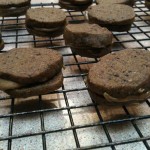Uncategorized
Words My Dog Knows
I have a Blue Lacy dog named Gus:
 He will be 12 years old this year. Over the years, he has learned many words and phrases. He understands basic commands such as come, sit, stay, and down, of course. But let’s explore some of the more interesting words Gus knows.
He will be 12 years old this year. Over the years, he has learned many words and phrases. He understands basic commands such as come, sit, stay, and down, of course. But let’s explore some of the more interesting words Gus knows.
Uh-oh. Gus knows when this is uttered in the kitchen to come a-running because something delicious just fell on the floor. Say it in another room and he ignores you.
Time for toothbrush. He follows you to the pantry for those chews that ostensibly clean his teeth.
Squirrel. Nothing more needs to be said.
Crow. Like squirrel, little more needs to be said, but he looks up in the sky.
Time for work. He barks at you until get your boots on. Same goes for, let’s get the paper, or walk, or outside, or take the trash up.
Tractor. Sam never says a word, but Gus knows when he puts in the ear protectors, it’s time to bark because the 2N is heading out into the orchard.
Get ’em up. This was very useful when we had more livestock here, for example, when Michael’s cashmere goats would get out of their pen or the chickens needed to be hustled back in the coop. In 2005, I thought about dispatching him to the Texas Legislature when they made one of many messes they’ve made with school financing at the same time they declared his breed the official state dog.
Given what’s going on in Austin this week, I may yet send him down there.
Get ’em up, Gus.
Venison steaks
Another favorite venison recipe, as promised, from Chili, two ways.
The first thing Mark often cooked after a successful hunting trip was the venison backstrap, or tenderloin. I know some people soak the meat in buttermilk or wine to smooth out any gaminess that might be in the meat, but Mark rarely did that.
Instead, he would cut the meat on the diagonal into small medallions and dredge them in flour that was seasoned with salt and pepper, fry it in a bit of cooking oil and then serve it up with mustard. Pretty delicious, just like that.
Sometime ago, I stumbled across a recipe that took advantage of the little bits left behind in the fry pan that made a nice sauce, and that’s the way we’ve served it since.
If you want to make the sauce, choose a cast-iron pan and olive oil for frying the venison — a scant tablespoon per pound of meat. After removing the meat from the fry pan (keep it warm on a platter nearby), pour about a 1/2 cup of stock into the pan to pull up all the bits. With the heat on very low (so you don’t curdle the sauce), add a teaspoon each of dijon mustard and horseradish, and 2 tablespoons of Greek-style yogurt. When it’s hot, plate the steaks and pour the sauce over.
Rainbow toast and sunshine strawberry jam
Sam limited his food choices when he was in elementary and middle school. Sometimes we took action, but otherwise we tried to keep a good humor about it.
I can remember taking the kids out for breakfast, usually when we were on the road, and as the rest of us were all scarfing down pancakes and eggs and grits and bacon and sausage, Sam would be opening a fun pack of cereal and spreading jam on an order of dry toast.
He expanded his food universe by trying all different kinds of jam. He settled into a routine where he would spread each piece of toast with all the jams at the table equally. Sometimes that could be four or five different flavors. When that happened, he called it rainbow toast.
Some of those pieces of toast became real works of art, kind of like that cool stuff baristas can do designing hearts or flowers or conifer trees in the foamy milk in your coffee.
He doesn’t do that anymore, but he hasn’t lost his appreciation for a good jelly or jam.
For a long time, I just made the classics, like grape and blueberry. Lately, I’ve been trying new combinations, like strawberry-rhubarb with ginger, and apple-tequila. He likes them for the most part. The prickly pear jelly was a bust, as far as he was concerned, and he doesn’t like the butters — so things I can do with figs and pears, he just passes on.
Today, we finished the “sunshine” strawberry jam. I got the recipe from Jamison and Jamison’s “A Real American Breakfast.” This is not a recipe where the list of ingredients tells you much. You have to read what they tell you. It’s an old recipe. I’d been wanting to make it for a very long time, even before I wrote this story.
After the first day in the sun, Sam said, “It smells great.” After the third day, Sam said the flavor was intense.
Yep. Sunshine in a jar. Rainbows on your toast. This recipe is going in the regular rotation.
UPDATE:
Because Tom Reedy wants the recipe:
2 pounds strawberries
2 to 3 cups sugar
2 to 3 tablespoons fresh lemon juice
Make sure you and your utensils are scrupulously clean. Discard berries that are bruised or otherwise ailing. Stem the berries and halve them, cutting out any cottony white cores. This can easily eliminate 1/2 pound of the berries. Weigh the berries and combine them with 3/4 cup sugar per 1/2 pound of berries. (Really, truly, I say, weigh them with your kitchen scale; no guessing.) Mash lightly with a potato masher or pastry blender until you have a goopy strawberry soup of sorts, a thick liquid with small but distinct berry segments (These segments are rather toothsome when the jam is done, so, I say, think about that when you stop mashing and decide if the bits are small enough for you.)
Pour into a shallow dish (I poured it into two ceramic baking dishes so it was no more than 1-inch deep.) Cover with cheesecloth secured with rubber bands. (This is Texas, cover it with a double layer.) Set out in the sun for the day. Bring back inside and refrigerate overnight and repeat the following day. If you live in a warm, dry, sunny climate, you’ll probably have jam by the end of the second day without doing another thing (The Jamison’s live in N.M., so I’ll bet they do.) In a more humid or cloud-covered setting, it will likely take another full day of sitting out (and overnight refrigeration) to get the proper gelled texture, less thick than commercial versions, but with definite body. It will help speed the evaporation if you stir the jam a time or two during the day. If rain is anticipated, leave the jam in the refrigerator rather than putting it out. (We had rain at the end of the third day, but by then the jam was done. Sam brought it in.)
When the jam is ready, sterilize 2 half-pint (1-cup) canning jars. (I had enough jam to fill two-cup jars, as you can see). Spoon the jam in the jars, leaving about 1/4 inch of headspace and refrigerate for up to several weeks. Freeze for longer storage.
Credit: Jamison, Cheryl Alters and Jamison, Bill. “Real American Breakfast.” New York: William Morrow, p. 404
Parenting is a contact sport
Some people like to claim their gray hair comes from things their kids did. I see my scars and remember.
I have a long skinny scar that runs from knuckle to knuckle on my ring finger that came while digging in the garden with Michael. He felt so badly when he saw that his little shovel missed its mark and drew blood.
I was surprised how strong he was.
I’ve got a knot on my forehead from trying to help build a fence for the cashmere goats, a 4H project that lived here for 5-6 years. I got clubbed so hard by a round of woven fence wire that was hung up on a t-pole — almost spring-loaded, like a giant mousetrap — that it should’ve killed me. But the kids were all standing there, so I told myself to take the hit and keep on ticking.
Today I went to work with an odd-looking burn on my chin, like a permanent dribble of hot chocolate. I thought for sure at least Bj would say something, but no one asked.
Last night, Sam was determined to learn how to cook fish tacos. He dropped in the first battered fish strip from such a height, the frying oil splashed. Sam got a few splashes on his arm and I took one on the chin. But by the third strip, he was dropping it in perfectly.
Like Jason Robards character said in Parenthood, parenting is “like your Aunt Edna’s ass. It goes on forever and it’s just as frightening” and is unlike football, since there’s no end zone where you get to spike the ball and do your little dance.
Except he missed the part where parenting is a contact sport.
Overheard in the Wolfe House #220
Peggy: Did you have some breakfast?
Michael (stopping in after an early morning dental appointment): Yeah. I found the spaghetti.
Peggy: Spaghetti?
Michael: There’s nothing like your spaghetti.
Overheard in the Wolfe House #219
Paige: I’m playing Spider Solitaire. It’s like solitaire on steroids.
Peggy: Is that better than regular steroids?
Book Report, Part 1: the spectrum of the ostrich effect and Promised Land
Most days my writing life feels split, by day reporting on local government affairs — which means lots of time on shale energy impacts here at Barnett Shale ground zero and the new adventures in hydraulic fracturing — and by night, pondering the richness of family life when it is touched by developmental disability.
But sometimes the two writing worlds collide in unexpected ways.
Currently, I’m reading Susan Schneider’s new book, The Science of Consequences: how they affect genes, change the brain and impact our world.
The book is a marvelous literature review for the lay reader. Everything, and I do mean everything, you want to know about the principles of learning from consequences seems to be in this book. Learning from consequences — applied behavior analysis — is huge in the autism world. I do plan on another post that will delve into that later. But for now, I’m enjoying the ride, getting my mind blown at least once per chapter; for example, in “The Dark Side of Consequences,” learning that positive consequences can be negative and negative consequences really aren’t.
Oh, snap!
So, I’m up to page 129, deep in the chapter “Observing and Attending,” and Schneider elegantly lays out the “ostrich effect.” As in, the opposite of what the former mayor of Dish, Calvin Tillman, has offered as a personal tagline: “once you know, you can’t not know.” Or, as in Promised Land, that electrifying moment when someone or something jerks your pretty little head out of the sand and your old wise heart starts pounding, knowing, readying, because what you choose next absolutely defines who you are.
Schneider highlights a whole body of behavioral research that shows people often prefer to look the other way rather than confront bad news. She writes, “We could hope that we humans would be wiser and more willing to take the potential disappointments of observing when it’s in our own best interest.” (p. 129)
But we don’t.
(We learned that lesson early in the Wolfe house. We let people, including “experts,” tell us Sam would “grow out of it” and for two years, and life got worse and worse. After we named the disability and tackled its issues one by one, the whole family’s quality of life got better each day.)
The first study Schneider puts out for the reader is Brock and Balloun’s 1967 classic “Behavioral receptivity to dissonant information.” The participants were asked to listen to a series of messages that were covered up by static, but they had to power to clear the static for three seconds by pressing a button. Researchers let the participants know the message topics and their order. The purpose was to see when they would clear the static and listen in. Smokers listened 35 percent less to a more accurate, but discouraging, message about the link between smoking and lung cancer than another message, which discounted the link. Nonsmokers listened in to both messages.
Bam.
Then, Schneider tells us about a Swedish study of investors and when they looked at their investment portfolios. Of course, they check more often during rising markets, something Vanguard reports, too.
Bam.
With that foundation set, Schneider moves us on to high-stakes, ever-more disturbing human behavior, such as the resistance of prosecutors — hey, jobs and self-image on the line here — when confronted with DNA evidence of a wrongful conviction (see Mistakes Were Made (but Not By Me). To date, some states won’t compensate the wrongly convicted, or even expunge records.
Or the resistance to get an HIV test, even though it is easy and inexpensive, even at the risk of infecting others. “Like cigarette smokers, they are rolling the dice, not wanting to observe and learn the truth,” Schneider writes. (p. 130)
Bam.
Of course, the logical conclusion of this section ends thusly:
“Historians still debate whether Albert Speer, Hitler’s minister of war production, knew about Hitler’s ‘final solution’ for the Jews. Whatever the case, Speer said later that ‘If I didn’t see it, then it was because I didn’t want to see it,’ and he alone at the Nuremburg trials accepted responsibility for the war crimes of the Nazi regime.” (p. 130-1)
Let that sink in for a minute — that full spectrum of the ostrich effect and what it means to humanity.
That’s why that supposedly implausible plot twist in Promised Land, as a storytelling device, has no cognitive dissonance for me. Too many years with boots on the ground in the Barnett, watching the ostrich effect over and over and over again.
But the storytellers in Promised Land still managed to break my heart in the final scene. Landman Sue Thomason (Frances McDormand) comes to the grocery counter to pay for pack of Trident and the store owner just gives it to her.
Overheard in the Wolfe House #212
Cappuccino cookies
For years, I’ve struggled to recreate the little Cappuccino cookies Pepperidge Farm used to put out. When I saw that King Arthur Flour was selling hazelnut praline paste, I knew I had a real shot at coming as close an an amateur could.
This is as close as I could get.
Cappuccino cookies
1 2/3 cup flour
1/4 tsp salt
1 tsp cinnamon
3/4 cup unsalted butter
1/2 cup white sugar
1/3 cup powdered sugar
2 T. espresso powder dissolved in 1 T. hot water
1 tsp. vanilla
2 T. ground coffee beans
Hazelnut praline paste
Sift the flour, salt and cinnamon into a small bowl and set aside. Cream butter and sugars. Add dissolved coffee, vanilla and coffee beans and mix until very well blended. Stir in flour mixture. Divide the dough in half and roll into round logs, wrap in parchment and chill for one hour.
Slice and bake at 350 degrees for about 9 minutes. When cool, spread one cookie slice with paste, top with another slice.
Just in time for Christmas and other holiday giving
Hey, Martha! See Sam Run, the Kindle edition.


